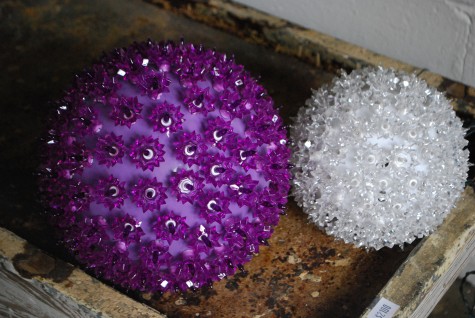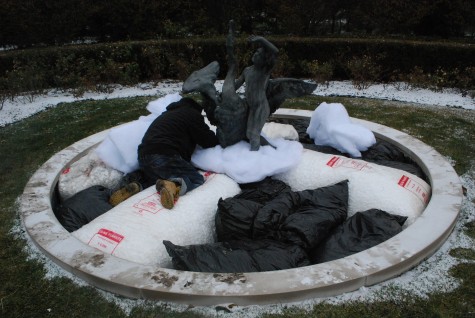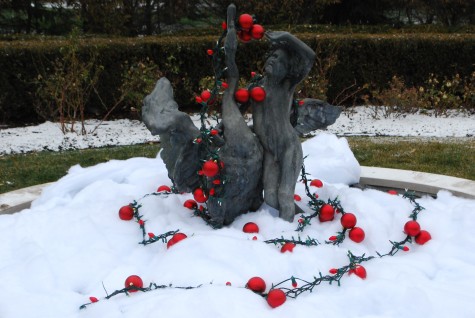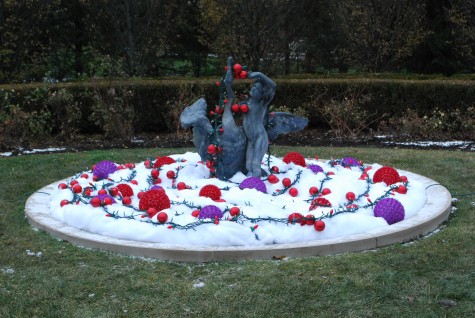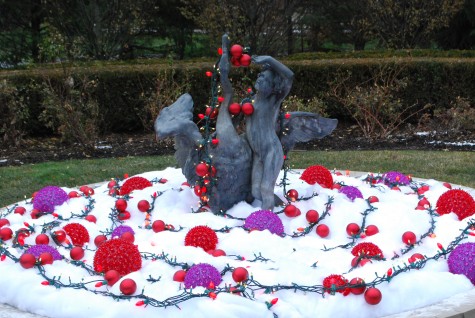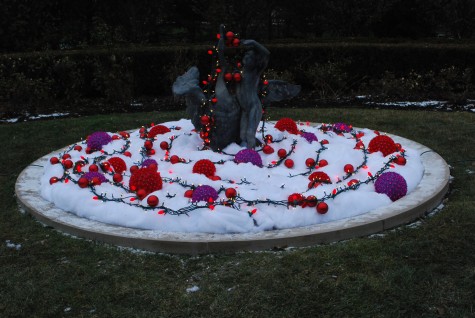At A Glance: Starlight Spheres
Wrap It Up
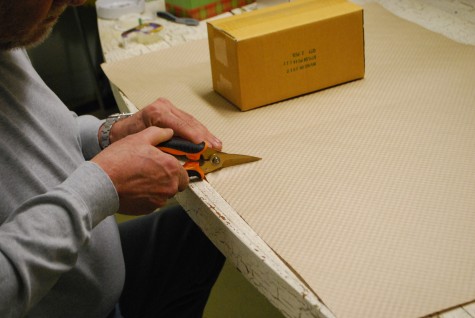 I think my landscaping season will be wrapped up by December 15. One recent project will be the last-a client who just closed on a new house November 15. We are trying to get the property in shape for a new landscape come spring. A lot of work got done last week, but there is another solid 10 days of holiday and winter projects to go. Then I will be involved in a wrapping up of a different sort.
I think my landscaping season will be wrapped up by December 15. One recent project will be the last-a client who just closed on a new house November 15. We are trying to get the property in shape for a new landscape come spring. A lot of work got done last week, but there is another solid 10 days of holiday and winter projects to go. Then I will be involved in a wrapping up of a different sort.
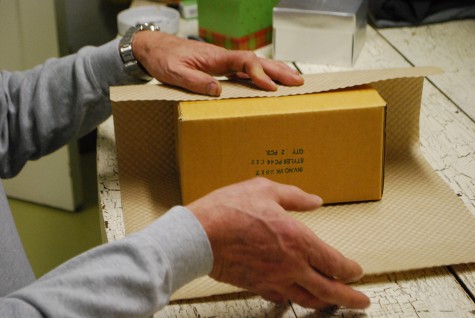 Every year, Buck in tow, I shop no end of places for wrapping paper and ribbon. He rolls his eyes, as I sort through the choices-none of which I really like. That done, we outfit the laundry table with all the necessary items-paper, tape, scissors. A big flat workspace-essential. Wrapping packages is one of the pleasures of the season. A thoughtful gift to another is a gift to me. What feels better than giving? Giving your garden the compost it needs. Giving a pot the water it needs. Giving encouragement to a niece about to go to college. Giving your all to a garden or landscape, some cause, or someone you really care about-this is the pleasure of the holiday season. The chance to express caring-this is in the air. The time and effort I take to wrap up a three-pack of sport socks for Buck says I think he is worth my time and effort.
Every year, Buck in tow, I shop no end of places for wrapping paper and ribbon. He rolls his eyes, as I sort through the choices-none of which I really like. That done, we outfit the laundry table with all the necessary items-paper, tape, scissors. A big flat workspace-essential. Wrapping packages is one of the pleasures of the season. A thoughtful gift to another is a gift to me. What feels better than giving? Giving your garden the compost it needs. Giving a pot the water it needs. Giving encouragement to a niece about to go to college. Giving your all to a garden or landscape, some cause, or someone you really care about-this is the pleasure of the holiday season. The chance to express caring-this is in the air. The time and effort I take to wrap up a three-pack of sport socks for Buck says I think he is worth my time and effort.
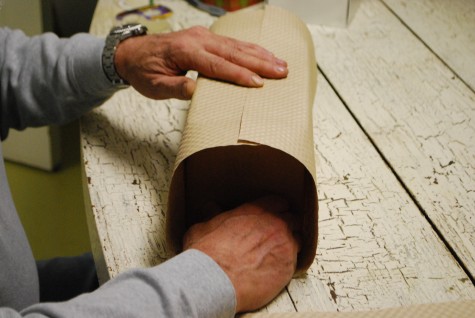 That said, Buck is much better at wrapping a package than I. Faced with a box that needs wrapping, he sizes the wrapping paper effortlessly. He measures with his eye, and remeasures-no tape goes on the wrap until he imagines that the coat he is making will fit perfectly. My holiday gifts to my best friends are standard fare. A rocking fry pan for one friend who has kids he is teaching to cook. A woolly handmade scarf for another who faces a winter just as cold as mine. But I want my boxes to look beautiful. The beautiful begins with persuading Buck to outfit the package with a wrap. This paper could not be more pedestrian. Heavy duty kraft paper is ordinarily used as packing material for industrial parts. Its heft makes it easy to work with; it shows no signs of the fumbling around it takes to get it positioned exactly where you want it.
That said, Buck is much better at wrapping a package than I. Faced with a box that needs wrapping, he sizes the wrapping paper effortlessly. He measures with his eye, and remeasures-no tape goes on the wrap until he imagines that the coat he is making will fit perfectly. My holiday gifts to my best friends are standard fare. A rocking fry pan for one friend who has kids he is teaching to cook. A woolly handmade scarf for another who faces a winter just as cold as mine. But I want my boxes to look beautiful. The beautiful begins with persuading Buck to outfit the package with a wrap. This paper could not be more pedestrian. Heavy duty kraft paper is ordinarily used as packing material for industrial parts. Its heft makes it easy to work with; it shows no signs of the fumbling around it takes to get it positioned exactly where you want it.
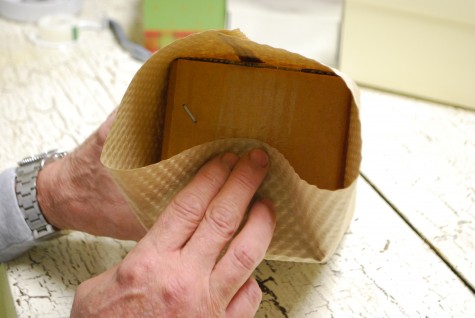 The bottom flap needs to cover the bottom half of the box-no mystery there. Unlike Buck, it will take me 3 or 4 tries to get this part right. But having a paper that will patiently keep its unblemished shape until I am ready to commit to a crease helps to keep the wrapping session fun. Flimsy holiday paper wrinkles on me every time I blink-so maddening.
The bottom flap needs to cover the bottom half of the box-no mystery there. Unlike Buck, it will take me 3 or 4 tries to get this part right. But having a paper that will patiently keep its unblemished shape until I am ready to commit to a crease helps to keep the wrapping session fun. Flimsy holiday paper wrinkles on me every time I blink-so maddening.
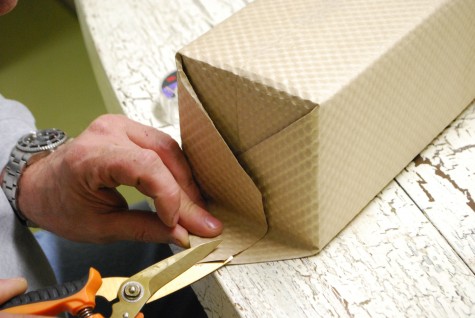 The bits and spots that do not work out get trimmed off. I have been known to wad up the overage under the surface, but that will be noticeable with a paper this thick. The heavily dimpled surface, meant to protect a fragile object, has a beautiful texture. Packing material as ornament for a gift box has that element of surprise going for it. A sturdy and utilitarian material chosen for its surface, and not its ordinary use make for a charming and unusual look.
The bits and spots that do not work out get trimmed off. I have been known to wad up the overage under the surface, but that will be noticeable with a paper this thick. The heavily dimpled surface, meant to protect a fragile object, has a beautiful texture. Packing material as ornament for a gift box has that element of surprise going for it. A sturdy and utilitarian material chosen for its surface, and not its ordinary use make for a charming and unusual look.
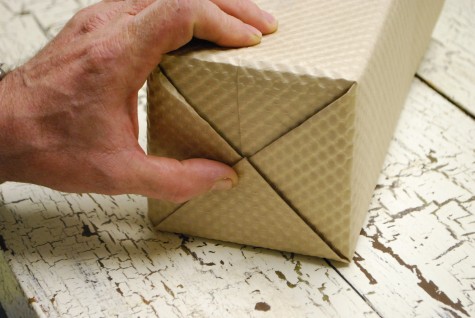 Clean and crisp creases that meet just about perfectly in the middle-a little time and effort come to some good. There are so many choices about how to take this look one step further.
Clean and crisp creases that meet just about perfectly in the middle-a little time and effort come to some good. There are so many choices about how to take this look one step further.
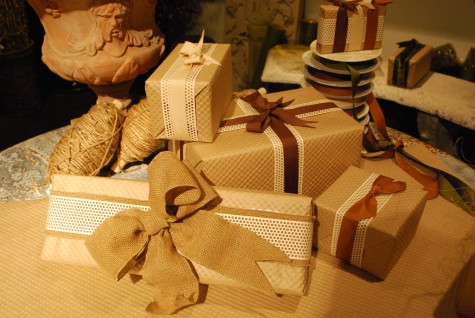 These materials represent some of Rob’s first foray into holiday wrap. I really like his choices. Grosgrain ribbon in cinnamon, brown and olive green is an old fashioned and low key material . A single loop bow with split trimmed tails is simple, and surprisingly elegant. A wide wired burlap ribbon makes the construction of a graceful bow easy.
These materials represent some of Rob’s first foray into holiday wrap. I really like his choices. Grosgrain ribbon in cinnamon, brown and olive green is an old fashioned and low key material . A single loop bow with split trimmed tails is simple, and surprisingly elegant. A wide wired burlap ribbon makes the construction of a graceful bow easy.
 This bow is Jenny’s work-definitely not mine. She has a gift for constructing beautiful bows. Though wired ribbon gives me a fighting chance, my method of construction usually involves a glue gun. The perforated paper you see under the ribbon-I found this at the hardware store. Its natural color contrasts beautifully with the darker materials. The perforations look great with the texture of the kraft paper. Lots of ordinary and readily available materials shine when put to a special purpose.
This bow is Jenny’s work-definitely not mine. She has a gift for constructing beautiful bows. Though wired ribbon gives me a fighting chance, my method of construction usually involves a glue gun. The perforated paper you see under the ribbon-I found this at the hardware store. Its natural color contrasts beautifully with the darker materials. The perforations look great with the texture of the kraft paper. Lots of ordinary and readily available materials shine when put to a special purpose.
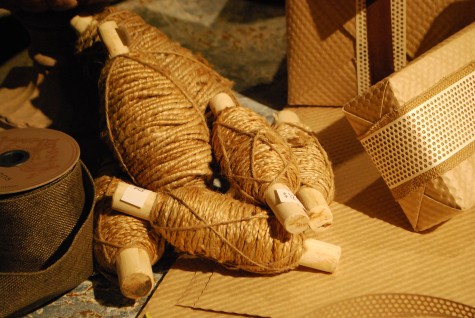 This slubbed gardener’s string is but one form of a material that is widely available. From butcher’s twine to waxed jute landscape twine to paper thread-the choices are many. A kitchen supply store, or a local nursery or garden center may have just the material you have been looking for. The ultimately easy to work with string-bark wire. All of your loops will stay just where you place them.
This slubbed gardener’s string is but one form of a material that is widely available. From butcher’s twine to waxed jute landscape twine to paper thread-the choices are many. A kitchen supply store, or a local nursery or garden center may have just the material you have been looking for. The ultimately easy to work with string-bark wire. All of your loops will stay just where you place them.

Materials different in every way than these may appeal to you. Finding them is a matter of letting your eyes do the choosing, no matter their intended purpose. I remember a package wrapping session in college just before the holiday break. Who could wrap the best package with brown paper grocery bags and school supplies? I have no memory of the winning design-but I do remember it was great fun.
Luca Della Robbia
 Luca Della Robbia, an Italian sculptor from the 15th century, is somewhat responsible for my passion for decorating with fruit at the holidays. Known for his glazed terra cotta rondels, he and his family sculpted voluptuous swags of fruit-the interpretations of which are still treasured by gardeners everywhere. Hand made Italian terra cotta pots ornamented with lemon swoops and mixed fruit swags in his style- sign me up.
Luca Della Robbia, an Italian sculptor from the 15th century, is somewhat responsible for my passion for decorating with fruit at the holidays. Known for his glazed terra cotta rondels, he and his family sculpted voluptuous swags of fruit-the interpretations of which are still treasured by gardeners everywhere. Hand made Italian terra cotta pots ornamented with lemon swoops and mixed fruit swags in his style- sign me up.
 Perhaps more responsible for my love for the holiday fruits is Louise Fisher. Put in charge of flowers and decor at Williamsburg in the mid 1930’s, she had a considerable hand in creating what I call the Williamsburg holiday look. Colonial Williamsburg was decorated for the holidays for the first time in 1936. Within a few few years, her research at the Library of Congress regarding American colonial holiday expression prompted her to sponsor a holiday decorating contest-the rest is history.
Perhaps more responsible for my love for the holiday fruits is Louise Fisher. Put in charge of flowers and decor at Williamsburg in the mid 1930’s, she had a considerable hand in creating what I call the Williamsburg holiday look. Colonial Williamsburg was decorated for the holidays for the first time in 1936. Within a few few years, her research at the Library of Congress regarding American colonial holiday expression prompted her to sponsor a holiday decorating contest-the rest is history.
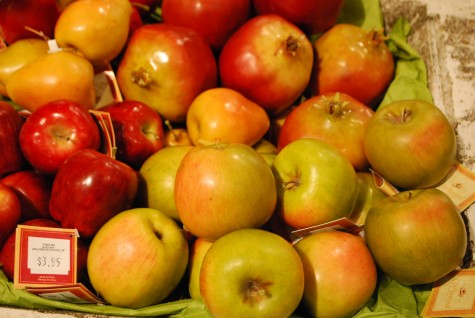 I grew up on those pictures of Williamsburg homes so beautifully decorated for the holidays. Each display was hand made-each incredibly thoughtful and beautiful. I was enchanted by the fresh garlands with tie backs of fresh fruit. The evergreen wreaths with an in-circle of apples-gorgeous. There is a long history of fruit ornament in this country. Vintage beaded fruit, glittered or sugared fruit-a sure sweet sign of the holidays-American style.
I grew up on those pictures of Williamsburg homes so beautifully decorated for the holidays. Each display was hand made-each incredibly thoughtful and beautiful. I was enchanted by the fresh garlands with tie backs of fresh fruit. The evergreen wreaths with an in-circle of apples-gorgeous. There is a long history of fruit ornament in this country. Vintage beaded fruit, glittered or sugared fruit-a sure sweet sign of the holidays-American style.
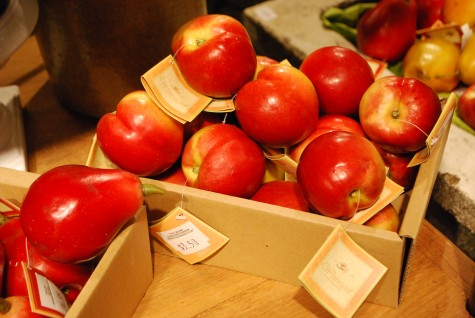 OK-I did make an evergreen wreath with fresh fruit for my front door. The second I finished piercing and wiring on all of my fruits, I was pleased. What came later was the dripping juice that froze on the porch-and the inevitable rot. Fruit can last a very long time. Once pierced, decay is initiated. I do not have the time to replace the fruit in my della robbia wreath 4 times over the holidays. I am thrilled that the faux fruit available to me now is incredibly beautifully done-convincing. These fruits have a plaster core-for weight. Who knows what material is used to create the surface. Who knows how the color is done. These faux fruits are astonishingly real in color and texture.
OK-I did make an evergreen wreath with fresh fruit for my front door. The second I finished piercing and wiring on all of my fruits, I was pleased. What came later was the dripping juice that froze on the porch-and the inevitable rot. Fruit can last a very long time. Once pierced, decay is initiated. I do not have the time to replace the fruit in my della robbia wreath 4 times over the holidays. I am thrilled that the faux fruit available to me now is incredibly beautifully done-convincing. These fruits have a plaster core-for weight. Who knows what material is used to create the surface. Who knows how the color is done. These faux fruits are astonishingly real in color and texture.
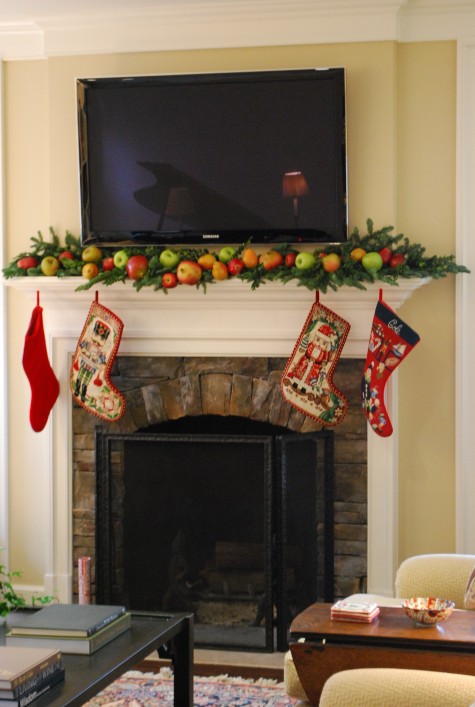 The fruits on this mantle will last the entire holiday season. They can be boxed and stored-and used for any number of holidays to come. When I use the fruits on a mantle, I pierce the skin with a long pick-that pick provides ballast. Each fruit is true to color and texture to a specific variety. Granny Smith apples, and pomegranites, lemons, limes and plums-they look delicious.
The fruits on this mantle will last the entire holiday season. They can be boxed and stored-and used for any number of holidays to come. When I use the fruits on a mantle, I pierce the skin with a long pick-that pick provides ballast. Each fruit is true to color and texture to a specific variety. Granny Smith apples, and pomegranites, lemons, limes and plums-they look delicious.
 An evergreen garland attached to a stair rail-a beautiful and fragrant nod to the season. My fruits, acorns, pine cones and ribbon wired in now and then, and at the newel posts-a traditonal American holiday expression.
An evergreen garland attached to a stair rail-a beautiful and fragrant nod to the season. My fruits, acorns, pine cones and ribbon wired in now and then, and at the newel posts-a traditonal American holiday expression.
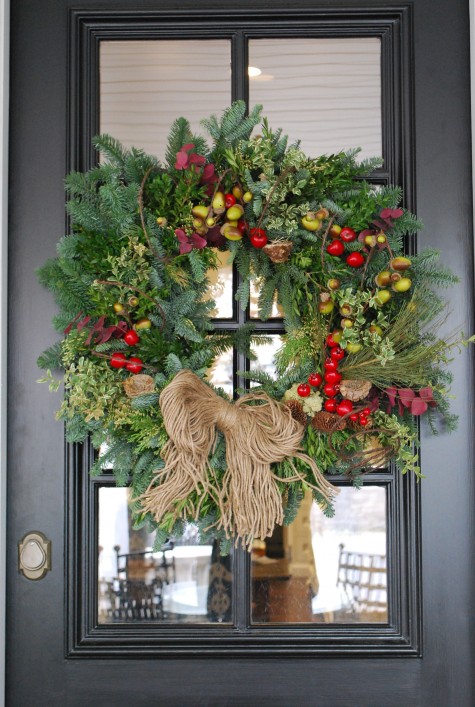 The back door wreath features mixed greens, a hemp rope bow, pine cones, red eucalyptus, reindeer moss, and bark wire garland. My faux fruits-the cherries. That red is intense. That each cherry needs to be glued on individually speaks to hand made.
The back door wreath features mixed greens, a hemp rope bow, pine cones, red eucalyptus, reindeer moss, and bark wire garland. My faux fruits-the cherries. That red is intense. That each cherry needs to be glued on individually speaks to hand made.
 A red and white wreath for the front door-this my client requested. The red comes from the Michigan holly stems, the cherries, a few red roses constructed from wood shavings, red twig dogwood, and some faux Washington apples. A red double faced satin bow-beautiful. The white-dried cirrus dusty miller and white glass ornaments. The intermediary-white variegated oregonia, green reindeer moss, and green/brown acorns.
A red and white wreath for the front door-this my client requested. The red comes from the Michigan holly stems, the cherries, a few red roses constructed from wood shavings, red twig dogwood, and some faux Washington apples. A red double faced satin bow-beautiful. The white-dried cirrus dusty miller and white glass ornaments. The intermediary-white variegated oregonia, green reindeer moss, and green/brown acorns.

The faux apples and pears in this wreath-they do fine. This holiday wreath has a broad mix of real, right from the garden, and faux. The double faced red satin ribbon has no problem handling the weather. The magnolia wreath came from a long ways away, but seems perfectly at home here. Faux fruits-they have come a long way too. They are really convincing. They do their part to help me express my admiration for Luca Della Robbia.
The Right Height
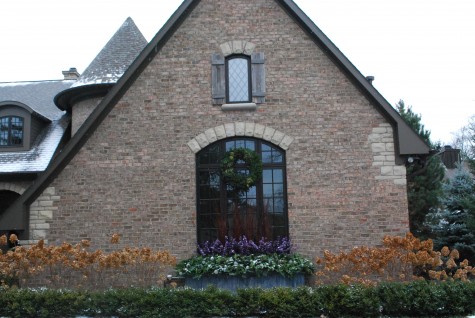 Though my own house is an amalgamation of arts and crafts and Mediterranean style, it could simply be described as a ranch. One story and longer than wide, it has a low profile. I do however have clients with very tall houses. Multiple stories and tall ceilings can make for a home that rises very tall out of the ground. Pictured is such a house-even the windows are very tall. Whether I am designing a landscape or a winter display, the elevation of a house should inform the design. The landscape and window box makes a very strong horizontal statement-counter to, and in contrast to the height of this window.
Though my own house is an amalgamation of arts and crafts and Mediterranean style, it could simply be described as a ranch. One story and longer than wide, it has a low profile. I do however have clients with very tall houses. Multiple stories and tall ceilings can make for a home that rises very tall out of the ground. Pictured is such a house-even the windows are very tall. Whether I am designing a landscape or a winter display, the elevation of a house should inform the design. The landscape and window box makes a very strong horizontal statement-counter to, and in contrast to the height of this window.
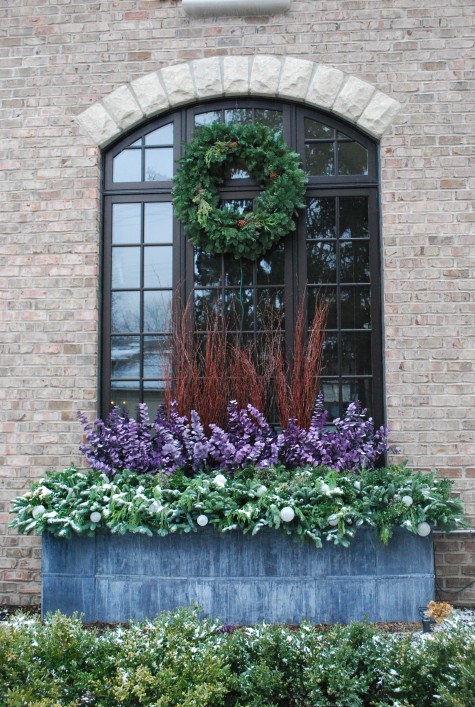 The irony of windows? That transparent material which transmits light to the interior of a house reads dark, or black from the outside during the day. This large window reads especially dark, given the pale brick. The winter display in this large box needs to address the window-not just the box. My client liked the combination of lilac eucalyptus and varnished birch twigs; I think the color combination is especially pleasing. I did the birch twigs densely-so they would read aginst the dark glass. The mixed greens in the box are a fine texture that contrasts well with the snowball light covers. A big box needs to have a lot going on-no one wants to make their audience sleepy. Repeating those mixed greens in a wreath secured within visual distance of the arch of this window makes for a complete thought.
The irony of windows? That transparent material which transmits light to the interior of a house reads dark, or black from the outside during the day. This large window reads especially dark, given the pale brick. The winter display in this large box needs to address the window-not just the box. My client liked the combination of lilac eucalyptus and varnished birch twigs; I think the color combination is especially pleasing. I did the birch twigs densely-so they would read aginst the dark glass. The mixed greens in the box are a fine texture that contrasts well with the snowball light covers. A big box needs to have a lot going on-no one wants to make their audience sleepy. Repeating those mixed greens in a wreath secured within visual distance of the arch of this window makes for a complete thought.
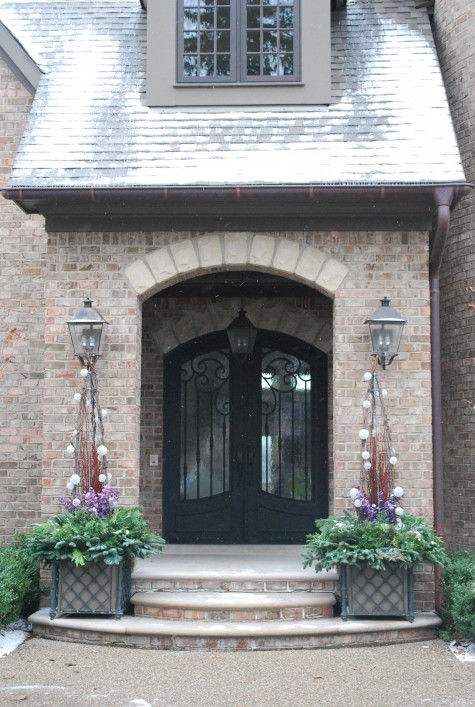 The entrance and front door are equally as imposing-the winter pots need to be the right height. The steel tuteurs covering in grapevine and lights add a good deal of height to the boxes flanking the door. This height is all to the good-every element in any given view needs to work in concert. Working in concert-this sounds so simple. I find it anything but. I fiddle, fume, add, subtract, redo, reconsider-a willingness for this kind of activity benefits the design of any landscape-summer and winter.
The entrance and front door are equally as imposing-the winter pots need to be the right height. The steel tuteurs covering in grapevine and lights add a good deal of height to the boxes flanking the door. This height is all to the good-every element in any given view needs to work in concert. Working in concert-this sounds so simple. I find it anything but. I fiddle, fume, add, subtract, redo, reconsider-a willingness for this kind of activity benefits the design of any landscape-summer and winter.
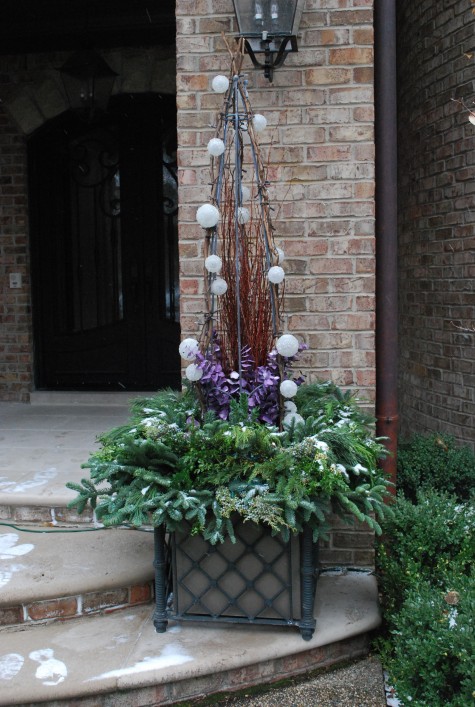 These tall plant tuteurs overlap the base of the iron light fixtures. My favorite part of this picture-the relationship, the juxtaposition of the rolled iron fixture to the rough cut natural grapevine. The lilac eucalyptus-I need more. The brown cords on the lights-thank heavens someone makes these.
These tall plant tuteurs overlap the base of the iron light fixtures. My favorite part of this picture-the relationship, the juxtaposition of the rolled iron fixture to the rough cut natural grapevine. The lilac eucalyptus-I need more. The brown cords on the lights-thank heavens someone makes these.
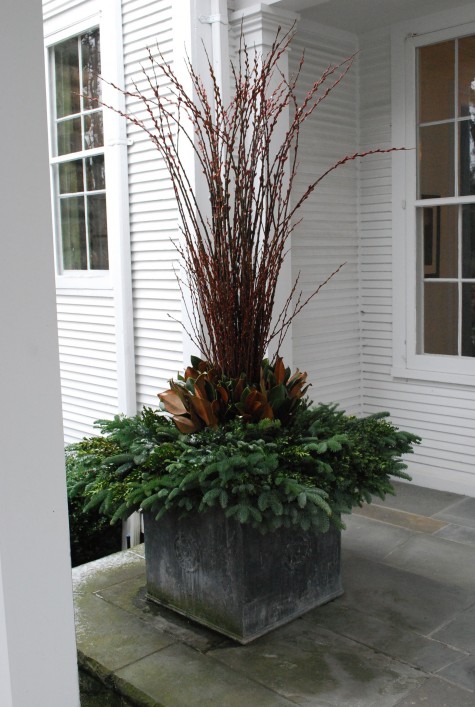 A substantial English lead box from Crowther’s is a very serious garden ornament. I am not really talking about the material here-I am talking about size. A wicker basket of this size would demand the same-a very tall centerpiece, an intermediary and generous level of magnolia-and a low wide blanket of noble fir and boxwood. The relationship of vertical elements to the horizontal elements makes for great visual interest. As much as I garden, I know when I go beyond a palette of materials to that stage when everything is cooking.
A substantial English lead box from Crowther’s is a very serious garden ornament. I am not really talking about the material here-I am talking about size. A wicker basket of this size would demand the same-a very tall centerpiece, an intermediary and generous level of magnolia-and a low wide blanket of noble fir and boxwood. The relationship of vertical elements to the horizontal elements makes for great visual interest. As much as I garden, I know when I go beyond a palette of materials to that stage when everything is cooking.
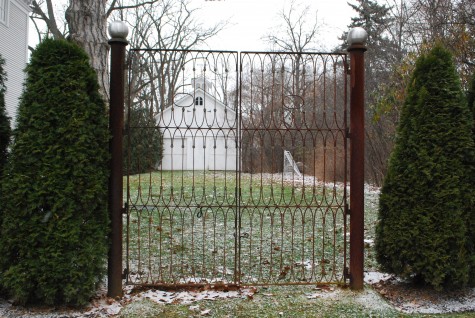 These tall Moroccan steel gates with lead dots-I cannot remember where Rob found them. Attached to steel posts with stainless steel finials-my addition. The height of these gates suits the property. The barn is in plain view, beyond. Given a few more years, the arborvitae fence will fill in-stay tuned.
These tall Moroccan steel gates with lead dots-I cannot remember where Rob found them. Attached to steel posts with stainless steel finials-my addition. The height of these gates suits the property. The barn is in plain view, beyond. Given a few more years, the arborvitae fence will fill in-stay tuned.
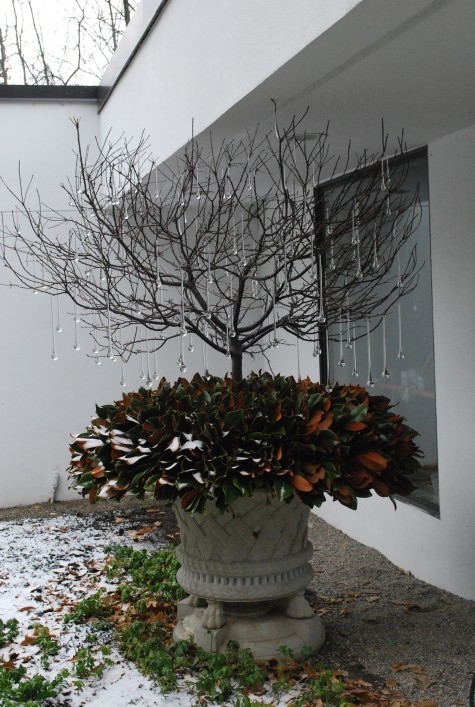
Mid century modern homes seem to be much more about low than tall. This client bought and chose to place a decidedly traditional limestone urn-half in, and half out of a long and sculpturally low underhang. I am impressed with her decision. The placement of this topiary tree skeleton hung with glass drops hovering inches above a blanket of magnolia branches-pressurized.
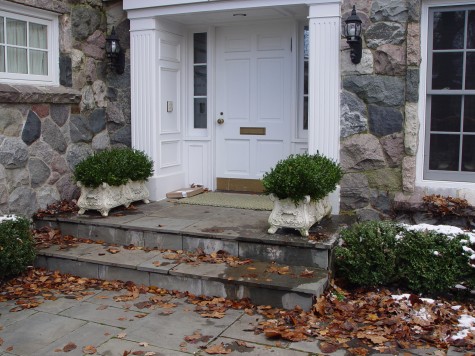 Short can make just as much impact as tall. These limestone planters stuffed with boxwood work here. The planters have lots of curves, and lots of detail-there is no need to challenge that. Simple, volumetric, and friendly-a concert.
Short can make just as much impact as tall. These limestone planters stuffed with boxwood work here. The planters have lots of curves, and lots of detail-there is no need to challenge that. Simple, volumetric, and friendly-a concert.
 I do have clients with reproductions of planters designed by Frank Lloyd Wright. I respect their choice. I restrict my materials, and I plan always to make the architecture of the planters the central metaphor. Low and simple seems to work.
I do have clients with reproductions of planters designed by Frank Lloyd Wright. I respect their choice. I restrict my materials, and I plan always to make the architecture of the planters the central metaphor. Low and simple seems to work.

These cast limestone pots are so beautiful. It was my idea to fill them for the winter in a way that did not in any way obstruct a view of the pots. The twig height-medium. Not tall, not short. The big idea here-no matter any rules, your good judgment-stick with that.
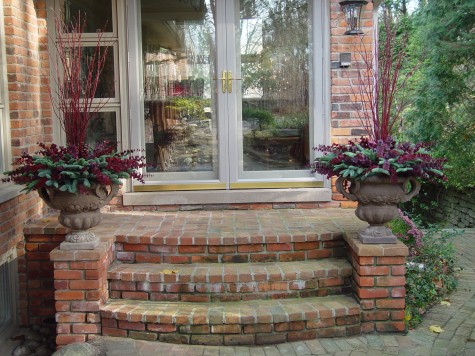
The tall and short of the matter-every individual situation asks for an individual solution. Your home, your garden, your landscape-it is uniquely yours. Trust your take. It really is good fun to construct the winter pots. Any composition can be exactly as tall and wide as what suits you. The moment you are done, you are ready for company.
